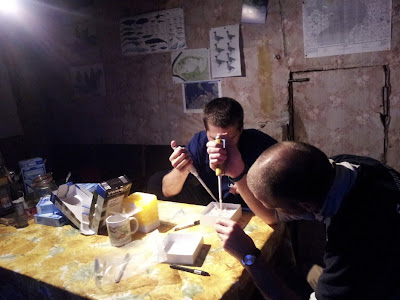The town of Naryan-Mar is our gateway for the field expedition to Tobseda, the nearly abandoned village located at the Kolokolkova Bay opening towards the Barents Sea. Only a couple of days were available to organize plenty of paper work with local authorities (arranging helicopter flights, registration of us foreigners, permission to enter the border zone, permission to transport biological samples) and to buy tools and food for several weeks to come. Very annoying for me was the final but negative message from the logistic company I ordered to send a respirometer to Naryan-Mar. After several attempts the company failed to get it through the customs. Measuring gas exchange in geese from Tobseda was one of my more ambitious research tasks. The Russian customs seem often to work in a grey zone of rules, where nobody really knows what the rules actually are. Naryan-Mar, in contrast to many other Arctic Russian settlements, is a booming town – thanks to big gas and oil reserves in Nenetsky Autonomous Okrug (NAO), the third biggest in exploitation in whole of Russia!
As planned, on 5 July the helicopter dropped a second
team of goose researchers in Tobseda, where this team stayed for 6 and half
weeks to study geese during the hatching, growing and moult period .
The old weather station house, which had been used during former
expeditions, provided again a very suitable field station – much more than just
a dry shelter. Most of our facilities we stored here over the years (some since
10 years) were still in useful condition.
New for this season was the use of a windturbine to provide ‘green energy’ for e.g. the freezer where we needed to store our biological samples . As one of the higher houses in the village it served also well as outlook post when searching for geese.
Our first working priority in early July was the
continuation of monitoring several hundred goose nests, which had been flagged
and monitored by an earlier team in June. We managed to fit 477 hatchlings with
a small aluminum web-tag carrying an individual number and placed on the food
web, hence the name. From many of those hatchlings we gathered a small blood
sample. Our hope was to recapture a reasonable number of goslings throughout
their growing period for an analysis of growth rate and telomere loss. After
hatch ended we went out to look for a suitable catching site on the local
saltmarshes but found out that nearly all broods had left the area. This was a
surprising event as compared to my experience from former years (2002-2005).
First we explored nearby sites in a radius of 8 km on foot and by canoes. Then
we used a catamaran to explore saltmarshes up to 20 km away.
But the
question where these many broods went after hatching remained a riddle. We
found still a couple of hundreds (also less than expected) number of adult failed
or non-breeders moulting in Tobseda. They all preferred to stay very close to
the village, often around the houses – despite our disturbing presence. We
believe that predation danger was the apparent reason for this behavior and the
fact that most broods left the study area.
One Arctic Fox had been occasionally
seen killing geese. But especially White-tailed Eagles have been increasing in
the area over the past decade or so. We recorded up to six eagles along a 7 km
route through the study area. We even found web-tags of goslings in pellets regurgitated
by eagles.
Nevertheless, we concentrated on the geese to catch.
On nine catching events we drove a satisfying number of them successfully on foot
and with canoes into our nets and catching pan for ringing and taking measurements
and samples
 |
| Master student Lisa Gijsen investigated them for presence of ectoparasites. |
Loaded with valuable samples, impressions from the tundra
and a final aerial view over Tobseda and the Barents Sea the helicopter brought
us back to Naryan-Mar on 20 August. From there and via Moscow team members
returned to their Western European domiciles by 24-26 August.
//Götz Eichhorn
Photographs by Helen Schepp and Joop van Eerbeek











Inga kommentarer:
Skicka en kommentar